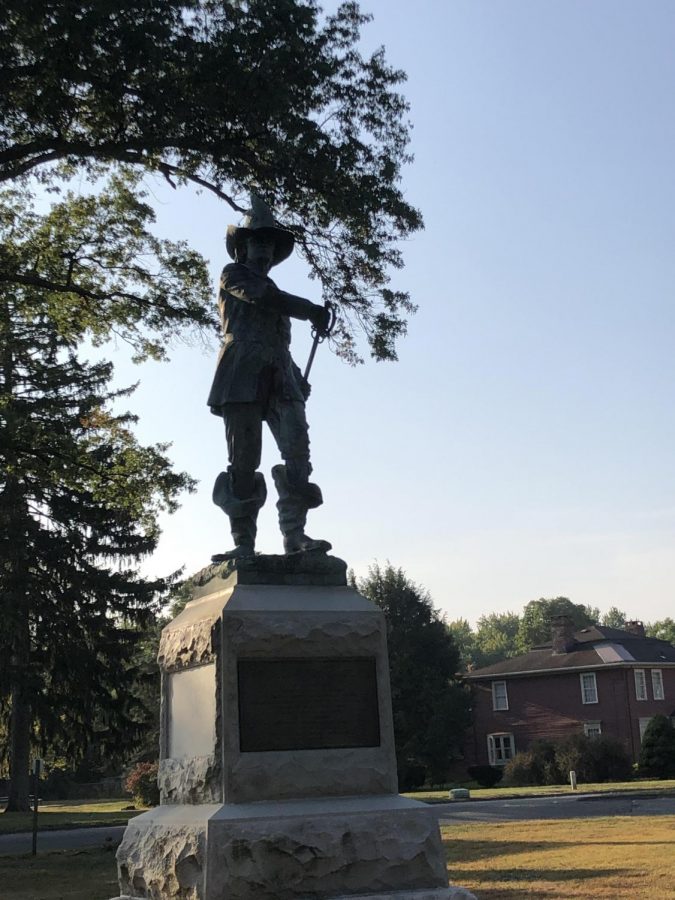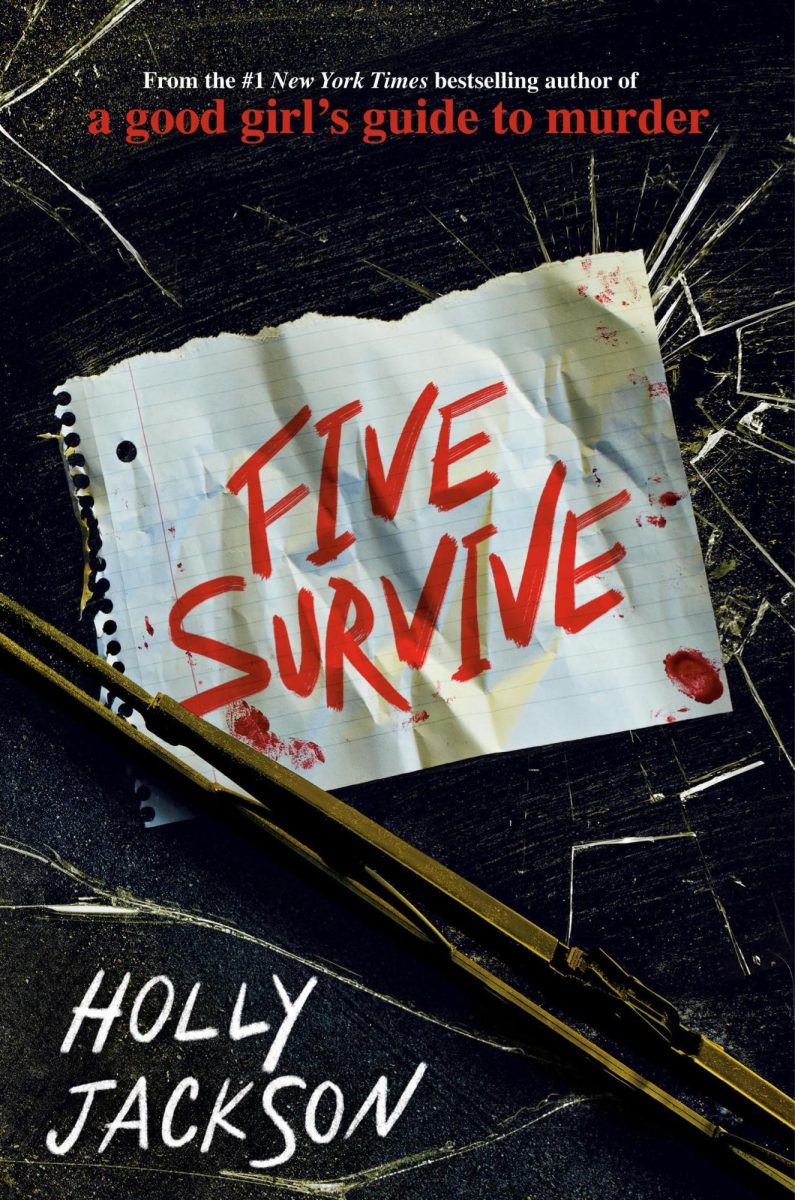Mason Dormitory Renaming: 5 years later
John Mason Statue on the Palisado Green–slated for removal in the near future
October 8, 2020
This summer, the Windsor Town Council voted to remove the John Mason statue from the town green, harkening back to the time when five years ago, Loomis Chaffee renamed Mason Hall to Howe Hall.
The 2020-2021 academic year marks the first year in which no current students attended the school at the same time Howe Hall was named Mason. As such, Mason Hall, as well as the history behind John Mason, has become a distant memory among the members of the school community.
This year, the history department has decided to reintegrate John Mason back into the school’s CL US History curriculum using the material produced by the Pequot tribal nation. Students in the course explored Connecticut’s history by learning about the Pequot War and the Mystic Massacre that resulted in many Native Americans being burnt alive.
Loomis’s archivist, Ms. Karen Parsons, was in charge of designing the course over the summer, and she decided to include this assignment in order to have students view this time period from the perspective of the indigenous voices. At the close of the lesson, teachers asked students to write a letter directed to some organizations on campus to advise them about the next steps the school should take.
“Some students were saying things like: we should have members of the Pequot nation come and tell that story from their nation’s perspective. Other people said we should continue to include it in more classes–the actual war itself, taught from many perspectives,” said Ms. Parsons.
In fact, John Mason was still integrated into the history curriculum two years ago, in the History From the Inside Out course taught by former History Faculty Dr. Mark Williams.
“I started teaching about the Pequot War in 1983. At that time Windsor was celebrating its 350th anniversary. In the history department, we were also engaged in integrating local history into the US History curriculum. In the 1980s, the school was 2/3 day students, and so we thought there should be more local history, especially since the first English settlement in Windsor was supposedly in the school’s ‘backyard’,” said Dr. Williams.
After reading the first paragraph about the Pequot War in Loomis’s US History textbook, Dr. Williams decided that he wanted to use his grant from the Connecticut Humanities Council to create teaching materials about the Pequot War for Connecticut high school teachers. When he created materials on the Pequot War, he added them to his class, “The World After Columbus,” which eventually became “History from the Inside Out.” Several of Dr. Williams students in “History from Inside Out” had the experience of visiting the Mason statue which had been relocated from Mystic to Windsor.
Similar to the current College Level US History assignment, Dr. Williams asked students to think of ways Loomis could remember Mason and continue the trajectory begun with the removal of John Mason’s name from the dormitory.
“I want them to struggle with the problem of how we remember the past and the people in it generally. I want them to remember how hard we need to think about a question like that, and how to be discerning about the information we have available that can help us think about it. It goes to the heart of Loomis Chaffee’s mission.” said Dr. Williams.
Long after its establishment, Dr. Williams’ history curriculum inspired Loomis Chaffee Alumni and former Student Council President Taseen Anwar ‘17 to rename Mason Hall to Howe Hall. A link to his Loomis Chaffee Log editorial, “Activism on Campus: What’s in a Name?” was provided as part of the CL US History assignment as a way to give broader context to the issue at hand.
In the article, Anwar wrote about how, during his visit to the John Mason statue during his “World History” class with Mr. Kevin Henderson and after he learned about Mason’s history as a military commander in the Mystic Massacre, he was confused as to why Loomis honored and named a dorm after a man who had led a genocide.
“I saw injustice at my own school, I saw the name of a mass murderer revered upon the wall. At that moment I cared. At that moment I knew this dorm name had to change,” Anwar wrote in “Activism on Campus, What’s in the name?,” a 2016 Log article.
As part of the name changing process, Dr. Culbert formed a committee, chaired by Mr. Eric LaForest, Keller Family Director of the Norton Center and history teacher, of 12 faculty and students, responsible for providing a full context for deliberations about Mason Hall and presenting their findings to the Board of Trustees.
“As this change and as the report that follows indicates, the changing tides of history have not been kind to John Mason. And, yet, his story and our community’s ongoing association with him demand our careful and considered attention. […] What follows is our best attempt at capturing the many historical and historiographical nuances of this story as well as our observations about other institutions’ actions in similar circumstances. ” their intentions were very clearly outlined in the Preface of the report.
Throughout the rest of the report, the committee compared the ways some other high schools and colleges navigated with the name changing decision.
“The process I think confused some faculty and students. It was a difficult moment for the school because it wasn’t clear at the time what the school would decide, and how, and why. It was a hard process,” Mr. LaForest said.
On May 16, 2017, Dr. Culbert sent a letter out to the campus community formally announcing the name change. History teacher Mrs. Lori Caligiuri was the dorm head of Mason/Howe at the time and commented on the initial reaction of the girls living in the dorm at the time.
“When the decision came down, it was interesting because I think that the Howe Girls, the Mason girls at the time, understood intellectually that it was the right thing to do, but there were some emotions around it as well, and I don’t think there were emotions around it because they were sad to lose the name of somebody who had killed lots, but there was a historic connection with the name for the people who had lived in Mason for a number of years,” Mrs. Caligiuri said.
“There’s always this tension with losing a tradition, even if you know it’s the right thing, it’s hard.”
However, efforts to quickly brand themselves as members of the Howe dorm such as creating “This is Howe We Do It” t-shirts and hosting a Sadie “Howekins” dance made former Mason girls start to identify themselves as Howe girls within a few months of the renaming.
Just like the history of John Mason, the importance of the Howe family is unknown to many current members of the Loomis community.
“[Mrs. Howe] was the first female dorm head of that dorm, so there was a connection in terms of female empowerment, so it all worked. That just worked for the dorm. Our girls were very happy with that name.” said Caligiuri, reflecting on the Howe girls’ reaction to the name change.
“[The Howes] gave their lives to the school in a way that few faculty members have over the past century plus. Their list of roles does not come close to the mark they made just by being themselves,” said Dr. Williams, a faculty member from 1975-2019.
As the Loomis community moves forward from this 5 year anniversary, it remains vital that we continue discussions about the history of both our school and the local area. Speaking on the CL US History assignment, Mr. LaForest stressed the importance of keeping this history at the forefront of our discussions.
“The fact that nationwide we’re having conversations about names of buildings and schools and statues and public commemorations of all kinds, that context is really important, but also, the fact that this is the first time where no current students would directly remember John Mason or Mason Hall, it’s an anniversary we should slow down and think about and see how we can step up our efforts to keep this history front and center for our students,” said Mr. LaForest.









